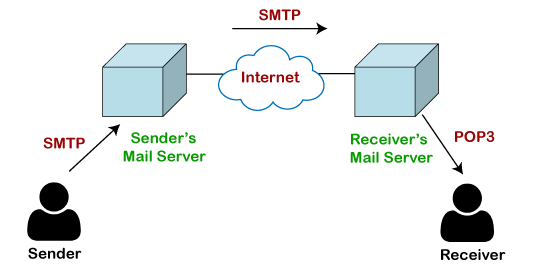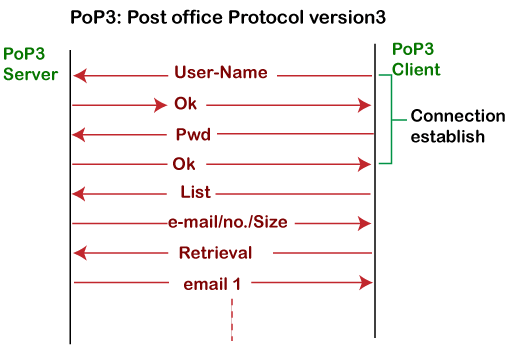POP ProtocolThe POP protocol stands for Post Office Protocol. As we know that SMTP is used as a message transfer agent. When the message is sent, then SMPT is used to deliver the message from the client to the server and then to the recipient server. But the message is sent from the recipient server to the actual server with the help of the Message Access Agent. The Message Access Agent contains two types of protocols, i.e., POP3 and IMAP. How is mail transmitted?
Suppose sender wants to send the mail to receiver. First mail is transmitted to the sender's mail server. Then, the mail is transmitted from the sender's mail server to the receiver's mail server over the internet. On receiving the mail at the receiver's mail server, the mail is then sent to the user. The whole process is done with the help of Email protocols. The transmission of mail from the sender to the sender's mail server and then to the receiver's mail server is done with the help of the SMTP protocol. At the receiver's mail server, the POP or IMAP protocol takes the data and transmits to the actual user. Since SMTP is a push protocol so it pushes the message from the client to the server. As we can observe in the above figure that SMTP pushes the message from the client to the recipient's mail server. The third stage of email communication requires a pull protocol, and POP is a pull protocol. When the mail is transmitted from the recipient mail server to the client which means that the client is pulling the mail from the server. What is POP3?The POP3 is a simple protocol and having very limited functionalities. In the case of the POP3 protocol, the POP3 client is installed on the recipient system while the POP3 server is installed on the recipient's mail server. History of POP3 protocolThe first version of post office protocol was first introduced in 1984 as RFC 918 by the internet engineering task force. The developers developed a simple and effective email protocol known as the POP3 protocol, which is used for retrieving the emails from the server. This provides the facility for accessing the mails offline rather than accessing the mailbox offline. In 1985, the post office protocol version 2 was introduced in RFC 937, but it was replaced with the post office protocol version 3 in 1988 with the publication of RFC 1081. Then, POP3 was revised for the next 10 years before it was published. Once it was refined completely, it got published on 1996. Although the POP3 protocol has undergone various enhancements, the developers maintained a basic principle that it follows a three-stage process at the time of mail retrieval between the client and the server. They tried to make this protocol very simple, and this simplicity makes this protocol very popular today. Let's understand the working of the POP3 protocol. 
To establish the connection between the POP3 server and the POP3 client, the POP3 server asks for the user name to the POP3 client. If the username is found in the POP3 server, then it sends the ok message. It then asks for the password from the POP3 client; then the POP3 client sends the password to the POP3 server. If the password is matched, then the POP3 server sends the OK message, and the connection gets established. After the establishment of a connection, the client can see the list of mails on the POP3 mail server. In the list of mails, the user will get the email numbers and sizes from the server. Out of this list, the user can start the retrieval of mail. Once the client retrieves all the emails from the server, all the emails from the server are deleted. Therefore, we can say that the emails are restricted to a particular machine, so it would not be possible to access the same mails on another machine. This situation can be overcome by configuring the email settings to leave a copy of mail on the mail server. Advantages of POP3 protocolThe following are the advantages of a POP3 protocol:
Disadvantages of POP3 protocolThe following are the advantages of a POP3 protocol:
Next TopicCIFS
|
 For Videos Join Our Youtube Channel: Join Now
For Videos Join Our Youtube Channel: Join Now
Feedback
- Send your Feedback to [email protected]
Help Others, Please Share









